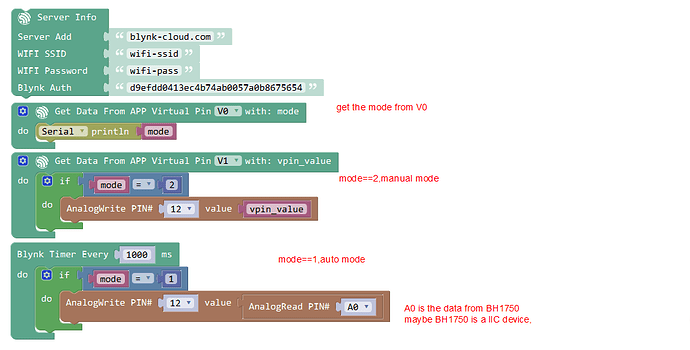I’m trying to develop a lighting control system.
by the app should open a menu for modes:
Automatic: controls the lamp intensity by the BH1750 sensor, as darkness increases the intensity increases, and shows the lux variation data on the screen
Manual: I can control the intensity of the lamp through the Slider.
I’m using arduino uno, sensor BH1750, and ESP8266
#define BLYNK_PRINT Serial
#include <ESP8266_Lib.h>
#include <BlynkSimpleShieldEsp8266.h>
#include <BlynkSimpleShieldEsp8266_HardSer.h>
#include <TimerOne.h> // Avaiable from http://www.arduino.cc/playground/Code/Timer1//— BIBLIOTECAS NECESSÁRIAS Sensor BH1750 —
#include <Dimmer.h>
#include <Wire.h>
#include <BH1750.h>//— DECLARAR VARIAVEIS GLOBAIS — sensor BH1750
Dimmer lamp(3);
BH1750 lightMeter(0X23);void sensor();
void slider();void sendUptime ()
{
uint16_t lux=lightMeter.readLightLevel();
Blynk.virtualWrite(4, lux);
delay(500);
}// ---- Rotina do Slider e Dimmer —
volatile int i=0; // Variable to use as a counter volatile as it is in an interrupt
volatile boolean zero_cross=0; // Boolean to store a “switch” to tell us if we have crossed zero
int AC_pin = 3; // Output to Opto Triac
int brightness = 128; // Dimming level (0-128) 0 = on, 128 = 0ff
int freqStep = 60; // This is the delay-per-brightness step in microseconds.// You should get Auth Token in the Blynk App.
// Go to the Project Settings (nut icon).
char auth = “c4b2d5c565214b869a7478f13a929451”;// Your WiFi credentials.
// Set password to “” for open networks.
char ssid = “Blynk”;
char pass = “franca9189”;// Hardware Serial on Mega, Leonardo, Micro…
//#define EspSerial Serial1// or Software Serial on Uno, Nano…
#include <SoftwareSerial.h>
SoftwareSerial EspSerial(6, 7); // RX, TX// Your ESP8266 baud rate:
#define ESP8266_BAUD 9600ESP8266 wifi(&EspSerial);
BLYNK_WRITE(V2) {
switch (param.asInt())
{
case 1:{ // Item 1
Serial.println(“Manual”); // Dimerização Slider
slider();
break;
}
case 2:{ // Item 2
Serial.println(“Automatico”); // Dimerização sensor BH1750
sensor();
break;
}
}
}// — Sub-Rotina do Slider —
void slider(){BLYNK_WRITE(V1)// slider brillo
{
int brillo = param.asInt();
brightness=brillo;
}
{
void zero_cross_detect() {
zero_cross = true;
i=0;
digitalWrite(AC_pin, LOW); // turn off TRIAC (and AC)
}//Turn on the TRIAC at the appropriate time
}void dim_check() {
if(zero_cross == true) {
if(i>=brightness) {
digitalWrite(AC_pin, HIGH); // turn on light
i=0; // reset time step counter
zero_cross = false; //reset zero cross detection
}
else {
i++; // increment time step counter
}
}
}}
// — Sub-Rotina do Sensor BH1750 —void sensor(){
uint16_t lux = lightMeter.readLightLevel();
Serial.print(“Light: “);
Serial.print(lux);
Serial.println(” lx”); // printa e pula a linha para o proximo comandoif (lux < 1200 ){
uint16_t lux = lightMeter.readLightLevel(); int valor = map(lux, 0, 1200, 200, 0); // Lê o valor em lux do sensor (de 0 a 1200 lux (estipulado como limite)) e converte para potência de acionamento do triac (de 100% a 0% (sendo uma proporção inversa)) int ilumina = map (valor, 0, 200, 0, 50); // Lê a variável "valor" em porcentagem e converte para um valor que será enviado para a lampada dimmerizar (de 0 a 200) Serial.print("valor: "); Serial.println(valor); Serial.print("ilumina: "); Serial.println(ilumina); lamp.set(ilumina); // Atualiza o valor da lâmpada delay(1500);}
else {
lamp.set(LOW); // Atualiza o valor da lâmpada}
delay(1500);
}void setup()
{
// Debug console
Serial.begin(9600);// Set ESP8266 baud rate
EspSerial.begin(ESP8266_BAUD);
delay(10);Blynk.begin(auth, wifi, ssid, pass, “192.168.1.39”,8080);
delay(10);
// You can also specify server:
//Blynk.begin(auth, wifi, ssid, pass, “blynk-cloud.com”, 80);
//Blynk.begin(auth, wifi, ssid, pass, IPAddress(192,168,1,100), 8080);// — Configuração Inicial Slider Dimmer —
pinMode(AC_pin, OUTPUT); // Set the Triac pin as output
attachInterrupt(digitalPinToInterrupt(2), zero_cross_detect, RISING);//attachInterrupt(0, zero_cross_detect, RISING); // Attach an Interupt to Pin 3 (interupt 0)
Timer1.initialize(freqStep); // Initialize TimerOne library
Timer1.attachInterrupt(dim_check, freqStep);// — Configurações Iniciais Sensor BH1750 —
// INICIALIZAR A INTERFACE I2C
Wire.begin();// CONFIGURANDO O BH1750
if (lightMeter.begin(BH1750::CONTINUOUS_HIGH_RES_MODE)) {
Serial.println(F(“BH1750 Advanced begin”));
}
else {
Serial.println(F(“Error initialising BH1750”));
}// INICIALIZA LÂMPADA DIMERIZADA
lamp.begin();}
void loop()
{
Blynk.run();
}
my program:
erro:
Usando biblioteca BlynkESP8266_Lib na pasta: C:\Users\Ewerton França\Documents\Arduino\libraries\BlynkESP8266_Lib (legacy)
Usando a biblioteca blynk-library-master na versão 0.5.4 na pasta: C:\Users\Ewerton França\Documents\Arduino\libraries\blynk-library-master
Usando biblioteca BlynkSimpleShieldEsp8266_HardSer na pasta: C:\Users\Ewerton França\Documents\Arduino\libraries\BlynkSimpleShieldEsp8266_HardSer (legacy)
Usando a biblioteca TimerOne na versão 1.1 na pasta: C:\Users\Ewerton França\Documents\Arduino\libraries\TimerOne
Usando a biblioteca Dimmer-master na versão 1.0 na pasta: C:\Users\Ewerton França\Documents\Arduino\libraries\Dimmer-master
Usando a biblioteca Wire na versão 1.0 na pasta: C:\Program Files\WindowsApps\ArduinoLLC.ArduinoIDE_1.8.15.0_x86__mdqgnx93n4wtt\hardware\arduino\avr\libraries\Wire
Usando a biblioteca BH1750-master na versão 1.1.3 na pasta: C:\Users\Ewerton França\Documents\Arduino\libraries\BH1750-master
Usando a biblioteca SoftwareSerial na versão 1.0 na pasta: C:\Program Files\WindowsApps\ArduinoLLC.ArduinoIDE_1.8.15.0_x86__mdqgnx93n4wtt\hardware\arduino\avr\libraries\SoftwareSerial
exit status 1
a function-definition is not allowed here before ‘{’ tokenPreformatted text
